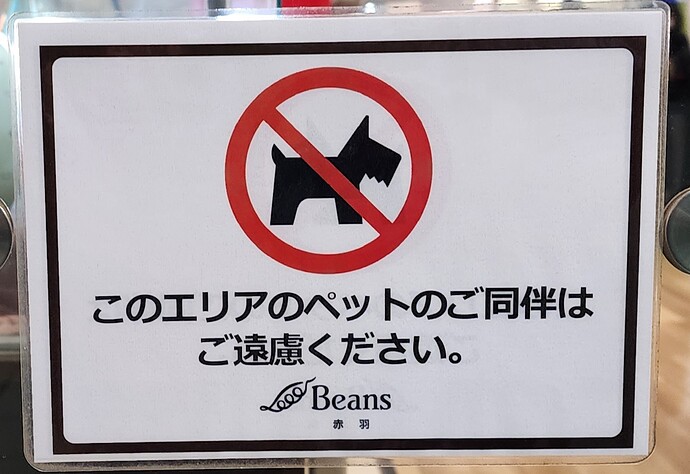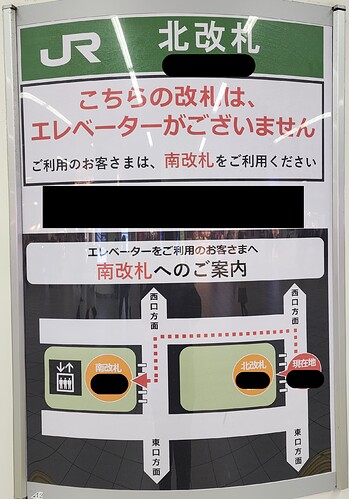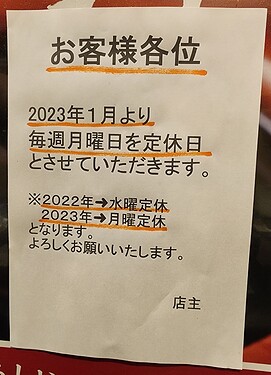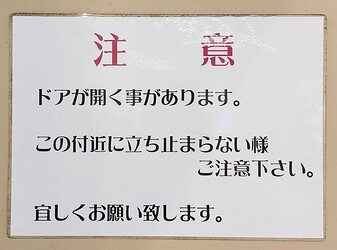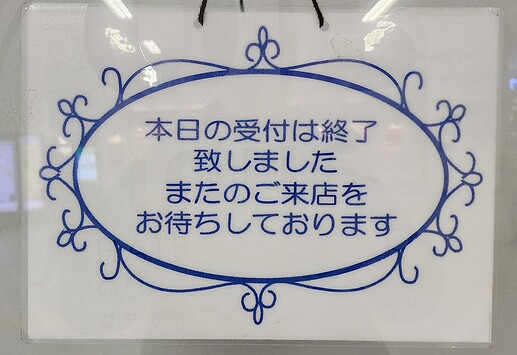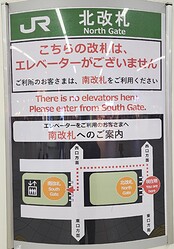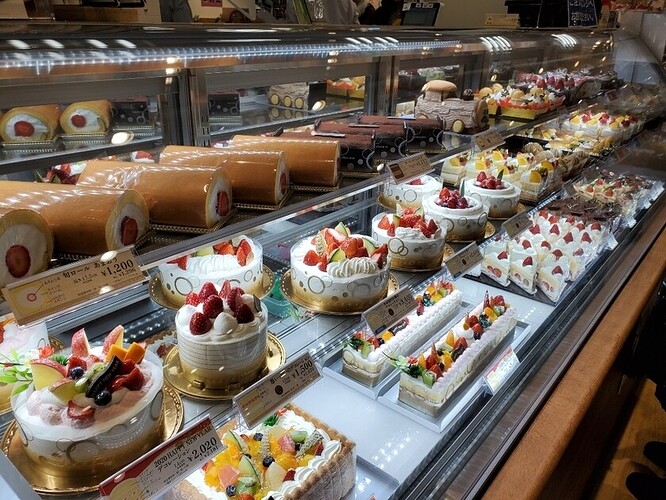What great fun!
Day one
このエリアのペットの同伴はご遠慮ください
Before I look anything up:
I know everything except the kanji (this area’s pet’s xx topic marker xx please) so, looking at the picture, my best guess is “no pets in this area”
And now to hit the dictionary:
同伴 - どうはん - accompanying; being accompanied by; going with
遠慮 - えんりょ - reserve; constraint; restraint;
Please refrain from bringing pets into this area.
Day two
When I see things like this, all this kanji, my eyes glaze over and my brain goes foggy! But luckily the map is easy to read, and even easier when I can decipher these two:
北改札 - きたかいさつ - north ticket gate
南改札 - みなみかいさつ - south ticket gate
So, with the answer in hand (to use the lift you need to enter through the south ticket gate), and a few minutes spare before my train leaves, I can try deciphering a bit more, just for fun:
こちらの改札はエレベーターがございません
There is no lift past this ticket gate
ご利用のお客さまは, 南改札をご利用ください
Passengers using (the lift), please use the south gate
I then decide I’ll never manage to figure out that final kanji on the poster (南改札へのごxxx) so just leave it and leg it to my train!
Edit: once on the train I pull out my smartphone and find that final kanji! 案内
Day three
So, having a job to do (buying a cake) I have little choice but to decipher this sign. At first glance all I can see it this:
Christmas xxx
Xxx 12/22
12/23~25はxxxxxx
Telephone reception xxxx go - don’t have
All xxxx xxxx xxxx don’t have
Xxx please
Can I buy a cake for tomorrow,? Not a chance!
But my actual understanding is awful. You wouldn’t believe I’ve lived in Japan for over ten years, would you? Normally I’d just ask the staff to explain, there’s always someone who can speak English, or just use the camera function in Google translate.
But I’m determined to finally crack this. But where to start? I look in Google Translate and find (for the first time today, can you believe this?) that it has a function in which you can draw an unknown kanji and look it up. It instantly recognises my first attempt, which is cool, and gives me the meaning “reserve”, but not the reading. Till I click on it, and there it is! Amazing! I now know that the first line is クリスマスよやく and says “Christmas reservations”. I now painstakingly work my way through the next line:
クリスマス予約 - クリスマスよやく - Christmas reservations
ご予約締切は12/22 - ごよやくしめきりは12/22 - The deadline for reservations is 12/22
That seems clear enough? Is it worth reading more? There might be some wriggle room here, though I doubt it…
12/23~25は購入後の取り置きや - 12/23~25はこうにゅうごの取り置きや
Something or other about sales or something? I don’t know!
At this stage I’m getting a headache, there are a load of people getting pissed of with me standing in front of the cakes fiddling on my phone, and my dog looks ready to pounce on another equally bored pooch further back in the line. No Christmas cake for the party again this year! Not my fault, they ought to have known to reserve before the 22nd!
Day four
Walk into many bakeries and you’ll see a pile of trays and a rack of tongs, and you’ll see people using the tongs to pick up the food they want and put it on their trays. It’s pretty obvious that you don’t use your fingers!
But Japan loves signs, especially ones telling you what not to do, so as soon as I saw this I knew the answer right away, just from those two katakana words that stick out in the first line:
パン - bread
トング - tong/s
But, let’s see if I can figure out the rest:
パンはトングを使用してお取りください
直接, 袋には手を触れないよう
お願いたします
Please use the tongs to take the bread
Please don’t touch the bags directly
使用 - しよう - use
取る - とる - take
直接 - ちょくせつ - directly
袋 - ふくろ - bag/s
手 - て - hand
触れない - 触れない - don’t touch
お願いたします - おねがいたします - please
The bags thing is because some of the food will be in wrappers.
Incidentally, I lived in Korea for some years before I came to Japan and once I arrived here I was very uncomfortable in Japanese bakeries. You have to put your food directly on the tray, trusting that it will be clean. It felt really dirty. In Korea you have no such worries as you also pick up a sheet of special paper to put on the tray first, making sure everything is kept perfect!
Day five
I’m really enjoying this project. These are the kind of signs I usually just ignore in my everyday life. Having to slow down and figure them out is very useful! Thank you!
And thank goodness for the write function on Google Translate! I never knew how useful it could be until this week!
お客様各位 - おきゃくさまかくい - To all our customers
2023年1月より - from January 2023
毎週月曜日を定休日
まいしゅうげつようびをていきゅうび
= every week / Mondays / day off
とさせていただきます
= grammar which is, to me, ridiculously indecipherable. Something to do with する in a super polite form. Basically, “we’re going to have Mondays as our closing day each week from next year”.
2022年 - 水曜定休 - 2022 - Wednesdays off
2023年 - 月曜定休 - 2023 - Mondays off
となります - will become
よろしくお願いいたします - super polite ending.
Someone’s going to be getting a regular three-day weekend. Let’s hope it’s everyone. Though I doubt it will be somehow!
Day six
Oh my goodness, today’s is a tough one. Just looking at it, I can see it is a warning of some kind, and in the first line I can make out something along the lines of the door being a thing that is open. To be honest, I’m totally stumped, so I’m going to get the dictionary out and break everything down:
注意 - ちゅうい - notice
ドアが開く事があります
ドア - door
が - identifier particle
開く - ひらく - to open
事 - こと - thing
があります - there is
Edit: Thank you so much to @Stormblessed for the following:
事があります is a set expression that has the meaning of “to be possible” or “happens sometimes”
So… This door sometimes opens
この付近に立ち止まらない様ご注意下さい
この - this
付近 - ふきん - vicinity
に - particle
立ち止まらない - たちとまらない - not come to a stop
様 - よう - appearing / way to (not Mr - さま!)
ご注意下さい - ごちゅういください - please take care
Please take care to not stop in this area.
宜しくお願い致します
よろしくおねがいいたします
Pretty please
Warning:
This door is in constant use and may open suddenly
Please don’t stand around in front of it
Thank you
Day seven
Okay, at first glance, it looked to me like this:
Japan’s reception is finished
Xxxwas done
Xxxxshopを
Waitxxx
Of course I realised that can’t be Japan and must mean “today”, so I look it up and lo-and-behold so it does! Okay, so reception is closed for the day, but let’s see what else is going on:
本日の受付は終了
ほんじつのうけつけはしゅうりょう
The reception desk is now closed
致しました
いたしました
Super polite past tense (the reception desk has now closed)
またのご来店を待しております
またのごらいてんをまちしております
Again + visit our store + wait
I was struggling a bit with this, but DeepL to the rescue:
We look forward to seeing you again!
The reception desk has now closed
We look forward to seeing you again
Now, sling your hook

